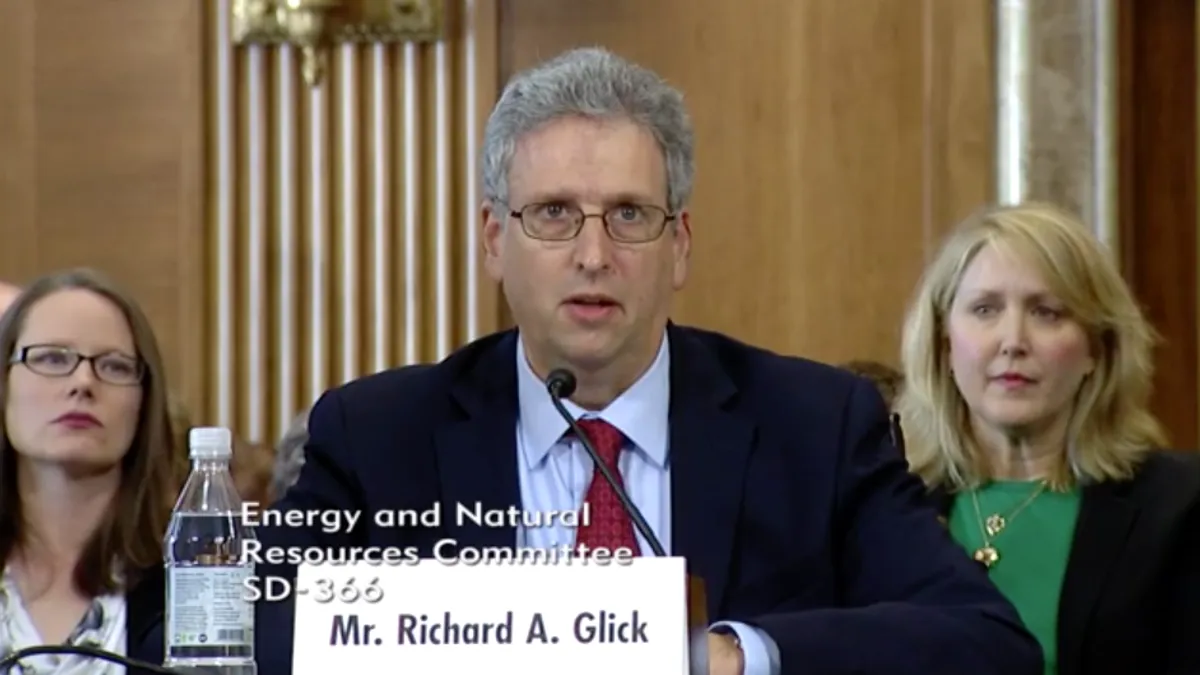Dive Brief:
-
Federal regulators on Thursday voted to effectively raise the bids of subsidized resources selling their power into PJM Interconnection's wholesale capacity market.
-
Under the plan, new resources receiving subsidies will now be subject to the Minimum Offer Price Rule (MOPR), which raises the price floor for those resources attempting to sell their power into the wholesale market. The move is intended to prevent potential "unacceptable market distorting effects" caused by state clean energy policies, according to Federal Energy Regulatory Commission Chair Neil Chatterjee. Commissioner Richard Glick was the sole dissenting vote of the three commissioners.
-
States, clean energy advocates and market observers fear FERC's move will severely hinder incentives intended to bring new zero emissions resources online, while favoring incumbent fossil fuels. A range of estimates have found the plan could raise market costs from a range of $2.4 billion to $8.4 billion annually.
Dive Insight:
FERC's Thursday decision is consistent with Chatterjee's previous efforts to steer federal energy policy away from renewables subsidies, based on his assessment that resources such as solar and wind have matured in the market and can compete on their own.
"This was about new entrants to the market competing on a level playing field. And if there's not a price suppressive impact, then they ought to be able to compete without subsidies," Chatterjee told reporters.
Stakeholders have been awaiting a final decision on a reform to PJM's market since the grid operator's market monitor first submitted the proposal in April of 2018 in order to address suppressed market prices, which the grid operator blamed on increased state subsidies for carbon-free resources, including nuclear and renewables. Others have blamed the grid operator's low capacity market bids on low natural gas prices and an oversupply of generation.
Commissioner Glick and clean energy advocates expressed frustration over FERC's decision, decrying it as an overstep in the markets that will hamper growing state interest in building out higher levels of renewable energy resources.
"There's a clear bias against new generation," Glick told reporters. "There's no reason to treat existing generation differently unless you're trying to promote existing generation to stay online, which is what I think is happening."
The majority of resources exempt from the MOPR are incumbent resources, including existing renewables procured under state renewable portfolio standards, existing energy efficiency, demand response and storage, and any resource that doesn't receive state subsidies. Federal subsidies for entrenched technologies, including fossil fuel plants, are not addressed in the order, a hypocrisy Glick and clean energy groups called out.
"Somehow we're not going to address those particular subsidies, even though those subsidies are having an effect under the chairman's theory of price suppression as well," said Glick.
"PJM is pretending there aren't subsidies in the markets they run, but the irony is they're everywhere," Mike Jacobs, senior energy analyst at the Union of Concerned Scientists said in a statement.
State level subsidies are broadly categorized as any direct or indirect "financial benefit" that would be used to build or procure new resources. That could particularly hinder the growth of storage and solar pairings and other resource technologies still nascent to the market, advocacy groups fear.
Chatterjee maintains the ruling is "resource neutral," though he ties the necessity of the move directly to state clean energy policies.
"I think I can almost assure you that, had no action been taken, the capacity markets absolutely would have unraveled," he told reporters. "State subsidization would have proliferated and that absolutely would have led to the demise of these capacity markets."
But stakeholder reactions fell squarely across resource lines, with nuclear and renewables advocates protesting the order and coal groups voicing their support.
"Far too much of the nation's essential coal fleet has been lost to market manipulation," National Mining Association President and CEO Rich Nolan said in a statement. "The expanded MOPR aims to restore fairness to the marketplace and is a timely first step in addressing the loss of the nation's baseload generating capacity."
"FERC's order is an unfortunate and unnecessary transformation of a limited rule designed to prevent market manipulation into a price support scheme for existing coal and natural gas power plants," Jeff Dennis, general counsel and managing director at Advanced Energy Economy, said in a statement.
Several states have been watching this proceeding closely and Illinois and New Jersey have both threatened to pull out of the market altogether if the MOPR is finalized, fearing impact on their state clean energy policies. And the broad definition of subsidies has put the effectiveness of larger clean energy initiatives, such as the Regional Greenhouse Gas Initiative, up in the air, just as more states are considering joining, noted Glick.
States initially had an opt-out option — the Fixed Resource Requirement — which would have allowed them to procure resources outside the wholesale market without fully leaving the market, but FERC determined that mechanism "would have had unacceptable market distorting effects that would have hampered competitive investment over the long term," Chatterjee told reporters.
PJM has 90 days to comply with the order and give FERC a timeline for its next auction. The grid operator is withholding comment until it is able to review the order, released Thursday night.















